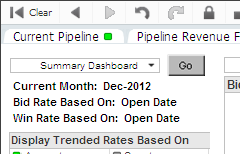
The Bid and Win Rate Analytics display trends in your bid rate and win rate over time and enable you to analyze your rates based on organization, principal, project manager, supervisor, client, source, or type. Using the detail tables, you can view pipeline amounts for the individual opportunities included in the rate calculations. |
In this topicBid Opportunities and No-Bid Opportunities Bid Rate Analysis Date and Analysis Period Won Opportunities and Lost Opportunities |
Capture Analytics calculates win rates in two ways: based on opportunity counts and based on opportunity pipeline amounts:
Number of won opportunities ÷ (Number of won opportunities + Number of lost opportunities)
Pipeline amount for won opportunities ÷ (Pipeline amount for won opportunities + Pipeline amount for lost opportunities)
The rates are displayed as percentages.
Your firm uses the opportunity open date as the bid rate analysis date. The total counts and pipeline amounts for the bid opportunities and no-bid opportunities with an open date in November 2012 are the following:
Bid opportunities: 7 opportunities, $2,000,000 total pipeline
No-bid opportunities: 14 opportunities, $3,000,000 total pipeline
Capture Analytics calculates the bid rates for November 2012 as follows:
Based on count: 7 ÷ (7 + 14) = .33 = 33%
Based on pipeline amount: 2,000,000 ÷ (2,000,000 + 3,000,000) = .4 = 40%
As part of the Costpoint Analytics configuration process, your system administrator specifies how Costpoint Analytics is to determine which opportunities are bid and no-bid opportunities for the purpose of calculating your firm's bid rates. That determination can be based on stage, on a user-defined field from the Opportunity table in GovWin Capture Management, or on a combination of the two.
For more information, see Bid and Win Rate Settings.
As part of the Costpoint Analytics configuration process, your system administrator specifies the date field from opportunity records in GovWin Capture Management that Costpoint Analytics uses to build the calendar for the bid rate portion of the Bid and Win Rate Analytics. That calendar is used to determine which opportunities to include in the bid rate calculations when you use the calendar bar to select an analysis period.
For example, your firm could use the opportunity open date. When you select a year in the calendar bar above the Bid Rate Trended chart to specify an analysis period for bid rates, Costpoint Analytics includes all bid and no-bid opportunities with an open date that falls within that year.
The bid rate analysis date field can be, and often is, different than the win rate analysis date field. If the two date fields are the same, however, the analysis period you select for the bid rate analytics is automatically applied to the win rate analytics as well.
The field your firm uses for the bid rate analysis date is displayed next to Bid Rate Based On in the upper-left corner of the tab:

Capture Analytics calculates win rates in two ways: based on opportunity counts and based on opportunity pipeline amounts:
Number of won opportunities ÷ (Number of won opportunities + Number of lost opportunities)
Pipeline amount for won opportunities ÷ (Pipeline amount for won opportunities + Pipeline amount for lost opportunities)
The rates are displayed as percentages.
Your firm uses the opportunity awarded date as the win rate analysis date. The total counts and pipeline amounts for the won opportunities and lost opportunities with an award date in November 2012 are the following:
Won opportunities: 7 opportunities, $2,000,000 total pipeline
Lost opportunities: 14 opportunities, $3,000,000 total pipeline
Capture Analytics calculates the win rates for November 2012 as follows:
Based on count: 7 ÷ (7 + 14) = .33 = 33%
Based on pipeline amount: 2,000,000 ÷ (2,000,000 + 3,000,000) = .4 = 40%
As part of the Costpoint Analytics configuration process, your system administrator specifies how Costpoint Analytics is to determine which opportunities are won and lost opportunities for the purpose of calculating your firm's win rates. That determination can be based on stage, on a user-defined field from the Opportunity table in GovWin Capture Management, or on a combination of the two.
For more information, see Bid and Win Rate Settings.
As part of the Costpoint Analytics configuration process, your system administrator specifies the date field from opportunity records in GovWin Capture Management that Costpoint Analytics uses to build the calendar for the win rate portion of the Bid and Win Rate Analytics. That calendar is used to determine which opportunities to include in the win rate calculations when you use the calendar bar to select an analysis period.
For example, your firm could use the opportunity awarded date. When you use the year options above the Win Rate Trended chart to specify an analysis period for win rates, Costpoint Analytics includes all won and lost opportunities with an awarded date that falls within that year.
The win rate analysis date can be, and often is, different than the bid rate analysis date. If the two date fields are the same, however, the analysis period you select for the win rate analytics is automatically applied to the bid rate analytics as well.
The field your firm uses for the win rate analysis date is displayed next to Win Rate Based On in the upper-left corner of the tab:

When your firm implements Capture Analytics, it can select two amount fields from opportunity records in GovWin Capture Management to analyze as pipeline. The options under Pipeline Amount on the Bid and Win Rates tab enable you to display bid and win rates calculated using amounts from either of those two fields.
Pipeline amounts used to calculate bid and win rates are unweighted amounts.
Unlike other analytics in Capture Analytics, the Bid and Win Rate Analytics cannot be filtered by stage. The configuration settings specify the stages that Capture Analytics uses to determine the opportunities to include. Filtering based on stage would result in incorrect rates.